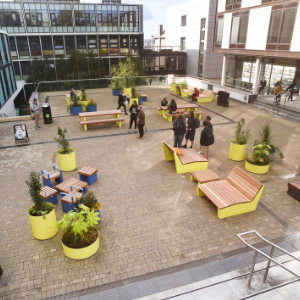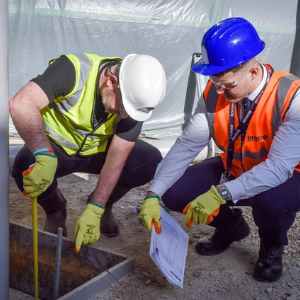Bollards play a vital role in controlling and directing traffic and serve the primary purpose of keeping vehicles out of certain areas. They come in various designs and materials tailored to specific needs, such as pedestrian safety and vehicle impact protection. Anti-ram bollards, such as our Sentinel Stoke Bollards, are ideal to deter vehicles from ramming into shopfronts and other assets, enhancing security.
Bollards come in several main types:
- Fixed bollards are permanently installed into the ground, often made from robust materials like steel, concrete, or cast iron, making them perfect for high footfall or high-security areas.
- Removable bollards can be detached or retracted as needed, which is ideal for places that need occasional vehicle access.
- Fold down bollards, which rise and fall manually, are common in areas where controlled access is necessary, such as car parks.
- Decorative bollards, designed to look good while offering some impact resistance, are often used in urban landscapes.
The materials used in bollard construction are crucial to their function and durability. For more information about the materials used to manufacture bollards and how they impact their use, read our Bollards Buyers Guide here.
Spacing requirements
The way bollards are spaced and placed is governed by several guidelines created by the Department for Transport (DfT) and the Centre for the Protection of National Infrastructure (CPNI). This is to ensure bollards provide an appropriate level of physical protection whilst minimising any negative impact on pedestrian movement.
The typical gap between bollards is 1200mm, which stops vehicles from getting through but provides enough space for pedestrians, including those using wheelchairs or pushchairs. Observation studies and literature reviews, such as the influence of bollards on pedestrian evacuation flow (TAL 01/16), show that under normal conditions, bollards spaced 1200mm apart have little impact on pedestrian convenience. People may need to adjust their body position slightly or slow down for a moment, usually less than a second.
In areas where vehicles need to be controlled more strictly, like the entrance to pedestrian zones, the spacing might be tighter, around 1000mm, to block even smaller vehicles.
According to the cycle infrastructure design (LTN 1/20) guidelines, bollards need to be spaced about 1500mm apart near cycle paths to ensure safety without obstructing cyclists. Reflective banding can also improve visibility, especially in low-light conditions.
Streetscape requirements
The streetscape requirements for bollards are essential to ensuring both functionality and aesthetic harmony within urban environments. Bollards need to comply with accessibility guidelines, ensure they do not obstruct pathways or create hazards, and be robust enough to withstand potential impacts without compromising pedestrian safety.
When choosing bollard fixings, root fixed bollards are usually more secure than baseplated or removable ones. However, this depends on factors like root depth, foundation size, and the size of the baseplate and fixings. For example, a baseplated bollard with a large baseplate and strong anchors can be more secure than a shallow-rooted bollard. The specific details of the installation can greatly affect security, so it's important to consider the environment and bollard specifications to ensure the best stability and protection.
The fourth edition of the Streetscape Guidance set out by Transport for London outlines that there should be an absolute minimum footway clear zone of 1000mm, with a preferred minimum of 2000mm. The street furniture zone can be up to 2000mm away from the kerb zone, which can accommodate a range of street furniture including bollards, seating, bins, bus shelters and cycle stands. A kerb zone should be kept completely free of street furniture to prevent damage from vehicles overhanging the carriageway edge.


These guidelines are specifically for implementation within London boroughs only.
Benefits of bollards
Bollards are a great solution for controlling traffic and keeping vehicles out of restricted areas. In areas with valuable assets or infrastructure, security bollards can deter vehicle impact and terrorist attacks.
Decorative bollards can beautify urban landscapes and heritage sites, adding to the visual appeal. Removable and retractable bollards give you flexibility, so areas that need vehicle access occasionally can be adapted as needed.
Security posts are ideal for home security, discouraging the theft of vehicles, caravans, or equipment in driveways.
The future of bollards
Looking ahead, bollards are set to transform from basic barriers to integral components of smart city infrastructure. With advancements in AI and IoT, these fixtures will become more responsive and adaptive. They'll be equipped with sensors and connectivity, enabling them to monitor and manage traffic flow efficiently.
By analysing real-time data, they will be able to adjust and optimise traffic patterns, enhancing safety for pedestrians and vehicles. IoT integration will also support broader urban planning efforts, contributing to energy efficiency and overall city management.
Comprehensive Range of Bollards by Broxap
Bollards are crucial in modern urban planning, providing a mix of safety, security, and aesthetic enhancement. As urban areas continue to evolve, bollards will remain essential in creating safe and secure environments for both pedestrians and vehicles.
Our dedicated sales team is available to assist you in finding the right bollards for your needs and ensure your project runs on budget and meets all requirements. As a manufacturer and supplier of one of the largest ranges of bollards in the UK street furniture market, we can provide barriers, posts, rails, and bollards to suit almost any application.
























